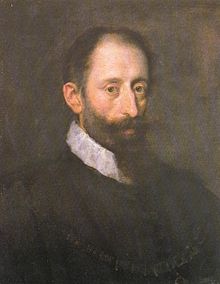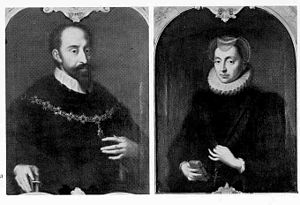William V, Duke of Bavaria
| William V | |
|---|---|
 William V, Duke of Bavaria (portrait by Hans von Aachen) | |
| Duke of Bavaria | |
| Reign | 24 October 1579 – 15 October 1597 (abdication) |
| Predecessor | Albert V |
| Successor | Maximilian I |
| Born | 29 September 1548 Landshut |
| Died | 7 February 1626(1626-02-07) (aged 77) Schleissheim Palace |
| Burial | St. Michael's Church, Munich |
| Spouse | Renata of Lorraine |
| Issue | Maximilian I, Elector of Bavaria Maria Anna, Archduchess of Austria Philipp William, Bishop of Regensburg Ferdinand of Bavaria Karl of Bavaria Albert VI of Bavaria Magdalene of Bavaria |
| House | House of Wittelsbach |
| Father | Albert V, Duke of Bavaria |
| Mother | Anna of Austria |
| Religion | Roman Catholicism |
William V (29 September 1548 – 7 February 1626), called the Pious, (German: Wilhelm V., der Fromme, Herzog von Bayern) was Duke of Bavaria from 1579 to 1597.
Contents
1 Education and early life
2 Reign
3 Cultural activity
4 Family and children
5 Ancestors
6 References
7 External links
Education and early life
William V was born in Landshut, the son of Albert V and Archduchess Anna of Austria.
He received a Jesuit education and showed keen attachment to the Jesuit Counter Reformation tenets. His title 'the Pious' was given to him because he devoted his daily routine to masses (when possible, several times a day), prayer, contemplation, and devotional reading. He took part in public devotions, processions, and pilgrimages.
William V's residence as crown prince was the ancient fortified Wittelsbach seat Trausnitz Castle in Landshut. Its upgrading from a Gothic fortification into a renaissance complex of truly representational proportions including the construction of an arcaded inner court were achieved in the decade between 1568 and 1578.
Reign
Like his Wittelsbach father and grandfather, William V was a strong supporter of the counter-reformation. He secured the archbishopric of Cologne for his brother Ernest with his campaign in 1583; his brother Ferdinand commanded the Bavarian army in the first 18 months of the Cologne War in an effort to secure the Electorate. Eventually, the Spanish army, under the command of Alexander Farnese, Duke of Parma expelled the Calvinist contender for the Electorate, Gebhard Truchsess von Waldburg, and Ernst secured sole possession of both the Electorate and the Archdiocese of Cologne. This dignity remained in the possession of the family for nearly 200 years. Two of William V's sons also followed ecclesiastical careers: Philipp Wilhelm of Bavaria became the Bishop of Regensburg and eventually a Cardinal, and Ferdinand of Bavaria succeeded his uncle as Archbishop of Cologne. In 1591, Philipp Wilhelm expelled Salzburg from the Berchtesgaden Provostry, the future possession of his son Ferdinand.
During William V's reign, non-Catholics were forced to leave Bavaria, and the so-called Geistlicher Rat, an ecclesiastical council, was formed to advise William V on theological affairs, independent of the traditional privy council or the treasury, which administered secular affairs. The Geistlicher Rat supervised and disciplined the duchy’s Catholic clergy through regular visitations; it controlled the Catholicism of all the state officials by issuing certificates documenting their annual confession and communion; it funded new Catholic schools, new Catholic colleges, new houses of religious orders, especially the missionary and educational ones, such as the Jesuits and Capuchins for men and the Ursulines for women. William V is responsible for numerous executions due to Witch-hunt in his duchy.
The Jesuit St. Michael's Church and college of the Jesuits were built in Munich between 1583 and 1597 as spiritual centers for the counter-reformation. William V's spending on Church-related projects, including funding missionaries outside Bavaria — as far away as Asia and the Americas—put tremendous strain on the Bavarian treasury. The Italian confidence man Marco Bragadino who was promising to make copious amounts of gold to erase the Dukes's debts was called upon by William V in 1590, and executed after he had failed. William V abdicated on 15 October 1597 in favour of his son, Maximilian I and retired into a monastery where he spent the remainder of his life in contemplation and prayer. He died in 1626 at the Old Schleissheim Palace and was buried at St. Michael's Church, Munich.
Cultural activity

Wilhelminische Veste (1860)
Already as crown prince in Landshut, William V patronised the arts. His court architect Friedrich Sustris was in charge of the decoration and remodelling of Trausnitz Castle in Landshut. Later when he ascended to rule, Sustris also undertook the expansion of the Munich Residenz, the construction of the adjoining college, the palace Wilhelminische Veste (the so-called Maxburg) in Munich, and St. Michael's Church.
In 1589, William V built the Hofbräu Brewery.
The Old Schleissheim Palace was founded by William V in 1598 as a renaissance country house and hermitage located close to Dachau Palace. The sculptors Hans Krumpper and Hubert Gerhard along with painters Peter Candid and Hans von Aachen were engaged at his court.
Family and children

William V, Duke of Bavaria and his wife, Renata of Lorraine
Married Renata of Lorraine (1544–1602) in Munich on 22 February 1568. They had 10 children:
- Christoph (born and died 23 January 1570).
- Christine (23 September 1571 – 27 April 1580).
Maximilian I (1573–1651), future Duke and Elector of Bavaria
Maria Anna of Bavaria (Maria Anna v.Bayern), 1574–1616, married Ferdinand II, Holy Roman Emperor in 1600
Philipp Wilhelm (22 September 1576 – 18 May 1598), Bishop of Regensburg from 1595, Cardinal from 1597
Ferdinand (6 October 1577 – 13 September 1650), Archbishop and prince-elector of Cologne (1612–1650)- Eleonore Magdalene (7 October 1578 – 18 April 1579).
- Karl (30 May 1580 – 27 October 1587).
Albert VI (1584–1666), in 1612 married Mechthilde v. Leuchtenberg (1588–1634)
Magdalene of Bavaria (4 July 1587 – 25 September 1628). Her tomb is in Hofkirche Neuburg a.d.Donau), in 1613 married Wolfgang Wilhelm, Pfalzgraf von Neuburg (1578–1663)
Ancestors
.mw-parser-output table.ahnentafel{border-collapse:separate;border-spacing:0;line-height:130%}.mw-parser-output .ahnentafel tr{text-align:center}.mw-parser-output .ahnentafel-t{border-top:#000 solid 1px;border-left:#000 solid 1px}.mw-parser-output .ahnentafel-b{border-bottom:#000 solid 1px;border-left:#000 solid 1px}
| Ancestors of William V, Duke of Bavaria | ||||||||||||||||||||||||||||||||||||||||||||||||||||||||||||||||||||||||||||||||||||||||||||||||||||||||||||||||||||||||||||||||||||||||||||||||||||||||||||||||||||||||||||||||||||||||||||||||||||||||||||||||||||||||||||||||||||||||||||||||||||||||||||||||||||||||||||||||||||||||||||||||||||||||||||||||||||||||||||||||||||||||||||||||||||||||||||||||||||||||||||||||||||||||||||||||||||||||||||||||||||||||||||||||||||||||||||||||||||||||||||||||||||||||||||||||||||||||||||||||||||||||||||||||||||||||||||||||||||||||||||||||||||||||||||||||||||||||||||||||||||||||||||||||||||||||||||||||
|---|---|---|---|---|---|---|---|---|---|---|---|---|---|---|---|---|---|---|---|---|---|---|---|---|---|---|---|---|---|---|---|---|---|---|---|---|---|---|---|---|---|---|---|---|---|---|---|---|---|---|---|---|---|---|---|---|---|---|---|---|---|---|---|---|---|---|---|---|---|---|---|---|---|---|---|---|---|---|---|---|---|---|---|---|---|---|---|---|---|---|---|---|---|---|---|---|---|---|---|---|---|---|---|---|---|---|---|---|---|---|---|---|---|---|---|---|---|---|---|---|---|---|---|---|---|---|---|---|---|---|---|---|---|---|---|---|---|---|---|---|---|---|---|---|---|---|---|---|---|---|---|---|---|---|---|---|---|---|---|---|---|---|---|---|---|---|---|---|---|---|---|---|---|---|---|---|---|---|---|---|---|---|---|---|---|---|---|---|---|---|---|---|---|---|---|---|---|---|---|---|---|---|---|---|---|---|---|---|---|---|---|---|---|---|---|---|---|---|---|---|---|---|---|---|---|---|---|---|---|---|---|---|---|---|---|---|---|---|---|---|---|---|---|---|---|---|---|---|---|---|---|---|---|---|---|---|---|---|---|---|---|---|---|---|---|---|---|---|---|---|---|---|---|---|---|---|---|---|---|---|---|---|---|---|---|---|---|---|---|---|---|---|---|---|---|---|---|---|---|---|---|---|---|---|---|---|---|---|---|---|---|---|---|---|---|---|---|---|---|---|---|---|---|---|---|---|---|---|---|---|---|---|---|---|---|---|---|---|---|---|---|---|---|---|---|---|---|---|---|---|---|---|---|---|---|---|---|---|---|---|---|---|---|---|---|---|---|---|---|---|---|---|---|---|---|---|---|---|---|---|---|---|---|---|---|---|---|---|---|---|---|---|---|---|---|---|---|---|---|---|---|---|---|---|---|---|---|---|---|---|---|---|---|---|---|---|---|---|---|---|---|---|---|---|---|---|---|---|---|---|---|---|---|---|---|---|---|---|---|---|---|---|---|---|---|---|---|---|---|---|---|---|---|---|---|---|---|---|---|---|---|---|---|---|---|---|---|---|---|---|---|---|---|---|---|---|---|---|---|---|---|---|---|---|---|---|---|---|---|---|---|---|---|---|---|---|---|---|---|---|---|---|---|---|---|---|---|---|---|---|---|---|---|---|---|---|---|---|---|---|---|---|---|---|---|---|---|---|---|---|---|---|---|---|---|---|---|---|---|---|---|---|---|---|---|---|---|---|---|---|---|---|---|---|---|---|---|---|---|---|---|---|---|---|---|---|---|---|---|---|---|---|---|---|---|---|---|---|---|---|---|---|---|---|---|---|---|---|---|---|---|---|
| ||||||||||||||||||||||||||||||||||||||||||||||||||||||||||||||||||||||||||||||||||||||||||||||||||||||||||||||||||||||||||||||||||||||||||||||||||||||||||||||||||||||||||||||||||||||||||||||||||||||||||||||||||||||||||||||||||||||||||||||||||||||||||||||||||||||||||||||||||||||||||||||||||||||||||||||||||||||||||||||||||||||||||||||||||||||||||||||||||||||||||||||||||||||||||||||||||||||||||||||||||||||||||||||||||||||||||||||||||||||||||||||||||||||||||||||||||||||||||||||||||||||||||||||||||||||||||||||||||||||||||||||||||||||||||||||||||||||||||||||||||||||||||||||||||||||||||||||||
References
^ ab Goetz, Walter (1953), "Albrecht V.", Neue Deutsche Biographie (NDB) (in German), 1, Berlin: Duncker & Humblot, pp. 158–160.mw-parser-output cite.citation{font-style:inherit}.mw-parser-output q{quotes:"""""""'""'"}.mw-parser-output code.cs1-code{color:inherit;background:inherit;border:inherit;padding:inherit}.mw-parser-output .cs1-lock-free a{background:url("//upload.wikimedia.org/wikipedia/commons/thumb/6/65/Lock-green.svg/9px-Lock-green.svg.png")no-repeat;background-position:right .1em center}.mw-parser-output .cs1-lock-limited a,.mw-parser-output .cs1-lock-registration a{background:url("//upload.wikimedia.org/wikipedia/commons/thumb/d/d6/Lock-gray-alt-2.svg/9px-Lock-gray-alt-2.svg.png")no-repeat;background-position:right .1em center}.mw-parser-output .cs1-lock-subscription a{background:url("//upload.wikimedia.org/wikipedia/commons/thumb/a/aa/Lock-red-alt-2.svg/9px-Lock-red-alt-2.svg.png")no-repeat;background-position:right .1em center}.mw-parser-output .cs1-subscription,.mw-parser-output .cs1-registration{color:#555}.mw-parser-output .cs1-subscription span,.mw-parser-output .cs1-registration span{border-bottom:1px dotted;cursor:help}.mw-parser-output .cs1-hidden-error{display:none;font-size:100%}.mw-parser-output .cs1-visible-error{font-size:100%}.mw-parser-output .cs1-subscription,.mw-parser-output .cs1-registration,.mw-parser-output .cs1-format{font-size:95%}.mw-parser-output .cs1-kern-left,.mw-parser-output .cs1-kern-wl-left{padding-left:0.2em}.mw-parser-output .cs1-kern-right,.mw-parser-output .cs1-kern-wl-right{padding-right:0.2em}; (full text online)
^ ab Wurzbach, Constantin, von, ed. (1860). "Habsburg, Anna von Oesterreich (1528–1587)" (in German). Biographisches Lexikon des Kaiserthums Oesterreich [Biographical Encyclopedia of the Austrian Empire]. 6. Wikisource. p. 151.
^ ab Riezler, Sigmund Ritter von (1897), "Wilhelm IV.", Allgemeine Deutsche Biographie (ADB) (in German), 42, Leipzig: Duncker & Humblot, pp. 705–717
^ abcd Brüning, Rainer (2001), "Philipp I.", Neue Deutsche Biographie (NDB) (in German), 20, Berlin: Duncker & Humblot, p. 372; (full text online)
^ Ferdinand I, Holy Roman Emperor at Encyclopædia Britannica
^ ab Charles V, Holy Roman Emperor at Encyclopædia Britannica
^ ab Obermayer-Marnach, Eva (1953), "Anna Jagjello", Neue Deutsche Biographie (NDB) (in German), 1, Berlin: Duncker & Humblot, p. 299; (full text online)
^ Rall, Hans (1953), "Albrecht IV.", Neue Deutsche Biographie (NDB) (in German), 1, Berlin: Duncker & Humblot, p. 157; (full text online)
^ Rall, Hans (1953), "Albrect III.", Neue Deutsche Biographie (NDB) (in German), 1, Berlin: Duncker & Humblot, p. 156; (full text online)
^ ab Wurzbach, Constantin, von, ed. (1860). "Habsburg, Friedrich V. der Friedfertige" (in German). Biographisches Lexikon des Kaiserthums Oesterreich [Biographical Encyclopedia of the Austrian Empire]. 6. Wikisource. p. 265.
^ ab Dotterweich, Helmut (1962). Der junge Maximilian: Jugend und Erziehung des bayerischen Herzogs und späteren Kurfürsten Maximilian I. von 1573 bis 1593 [The Young Maximilian: Youth and Education of the Bavarian Duke and Later Elector Maximilian I from 1573 to 1593]. R. Pflaum. p. 188. Retrieved 28 August 2018.
^ ab Philip I, King of Castile at Encyclopædia Britannica
^ ab Chisholm, Hugh, ed. (1911). "Joanna". Encyclopædia Britannica. 15 (11th ed.). Cambridge University Press.
Chisholm, Hugh, ed. (1911). "Joanna". Encyclopædia Britannica. 15 (11th ed.). Cambridge University Press.
^ ab Casimir IV, King of Poland at Encyclopædia Britannica
^ ab Noubel, P., ed. (1877). Revue de l'Agenais [Review of the Agenais] (in French). 4. Société des sciences, lettres et arts d'Agen. p. 497.
- Encyclopædia Britannica, 1910 edition (Google Print, p.548)
External links
- genealogy
William V, Duke of Bavaria House of Wittelsbach Born: 29 September 1548 Died: 7 February 1626 | ||
| Regnal titles | ||
|---|---|---|
| Preceded by Albert V | Duke of Bavaria 1579–1597 | Succeeded by Maximilian I |